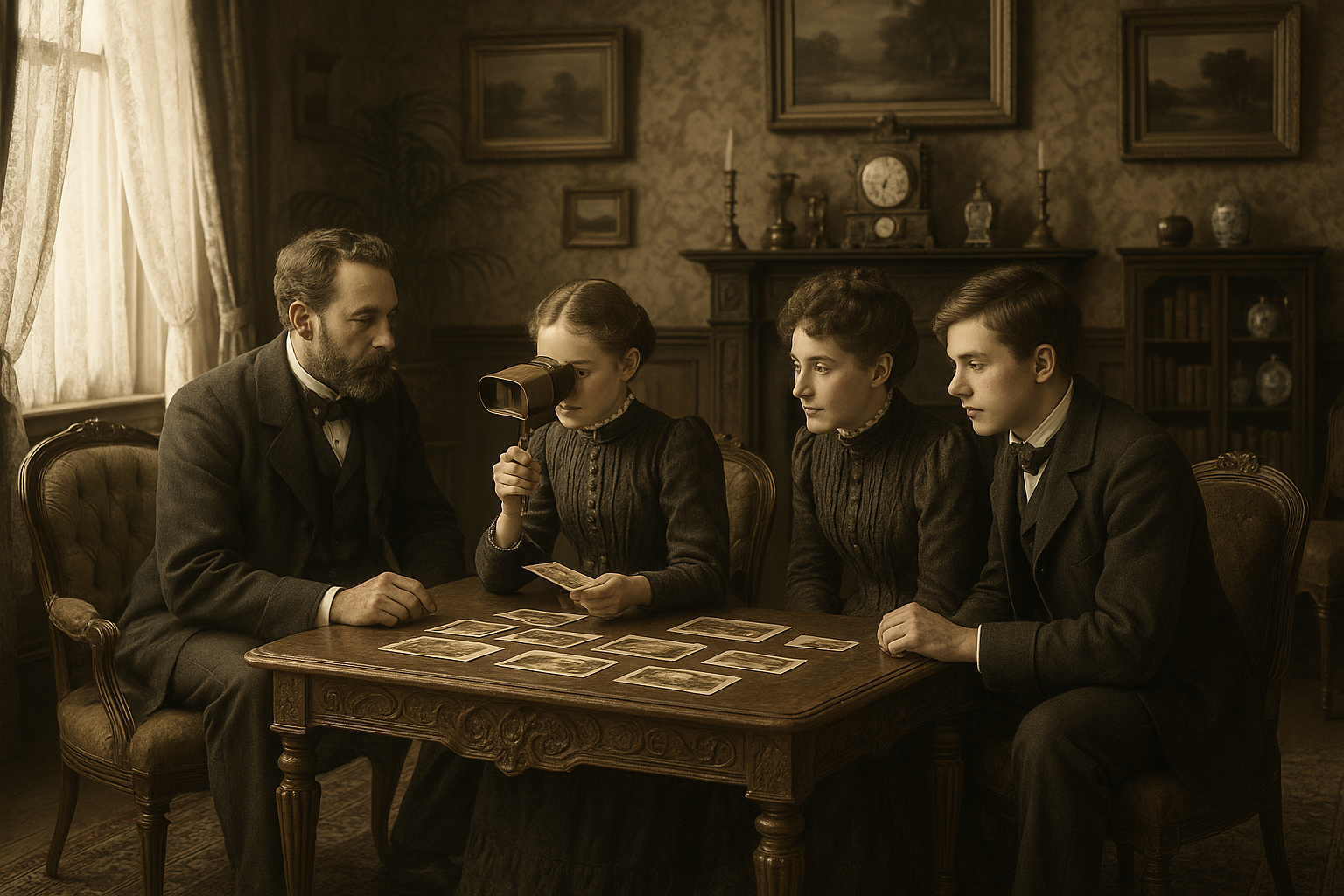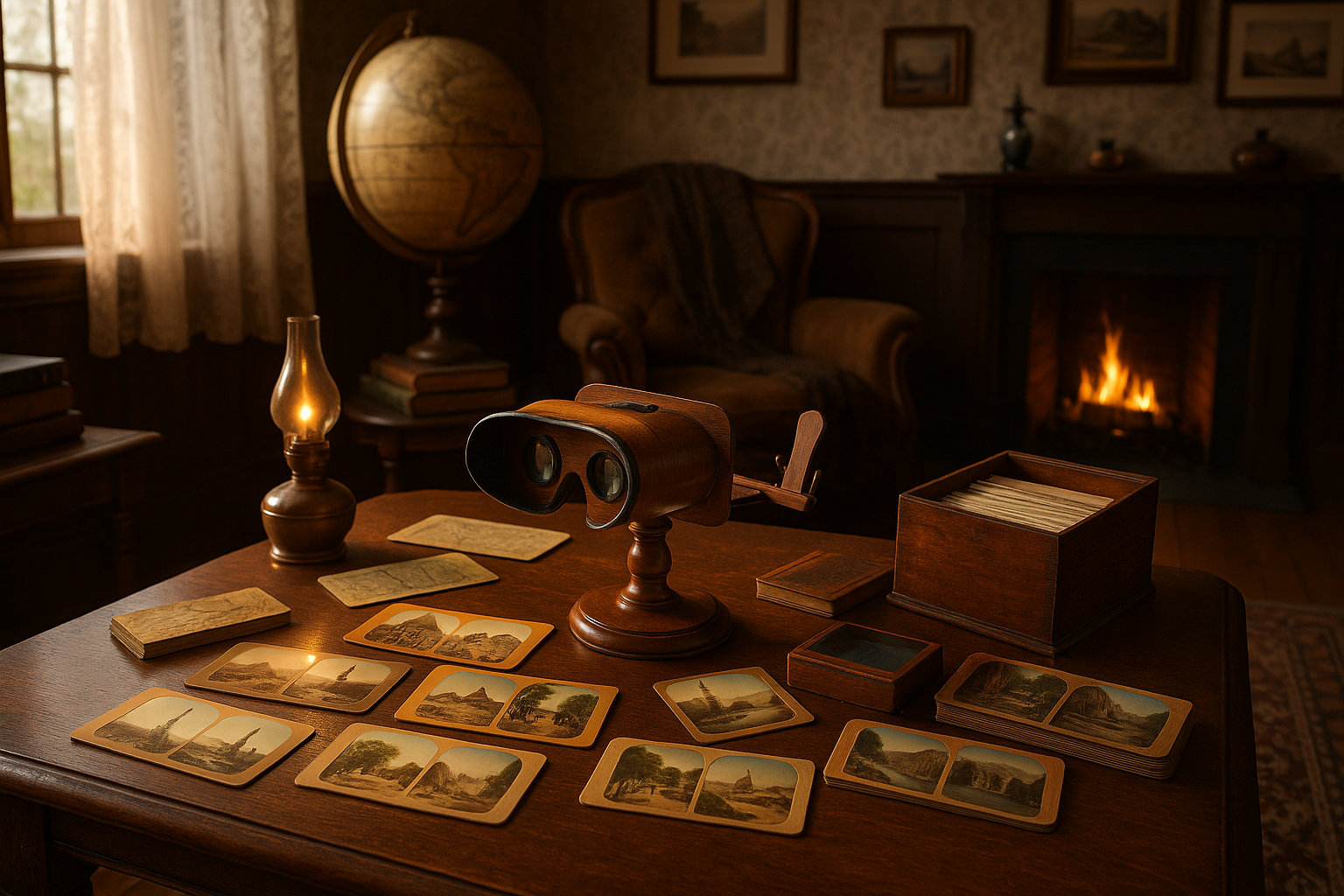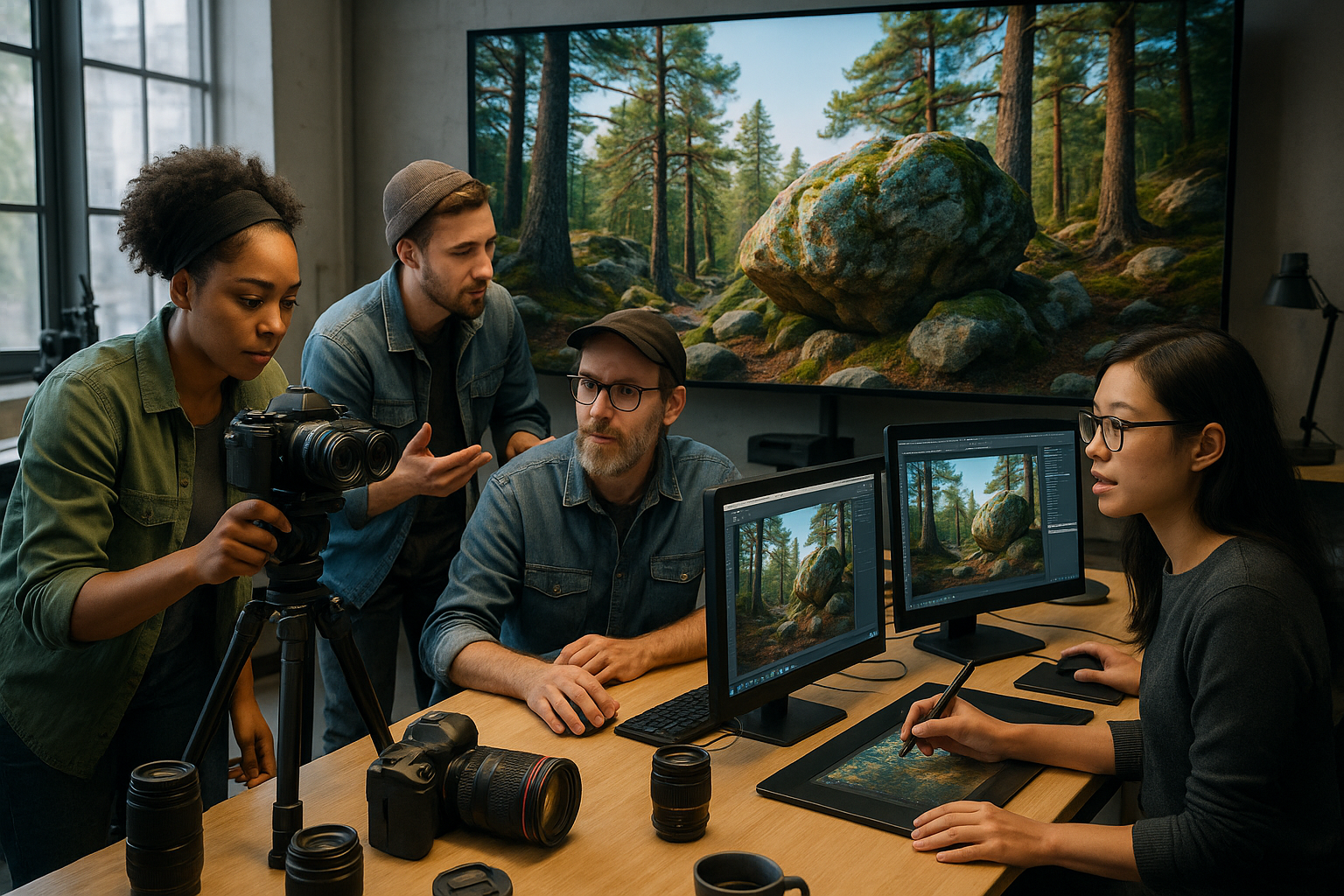The stereoscope revolutionized how people experienced visual media in the 19th century, creating immersive three-dimensional images that captivated audiences worldwide and laid groundwork for modern virtual reality.
🔍 The Birth of Dimensional Viewing
When Sir Charles Wheatstone invented the stereoscope in 1838, he unleashed a technological marvel that would transform visual entertainment for generations. This ingenious device exploited the principle of binocular vision, presenting slightly different images to each eye to create the illusion of depth. The stereoscope wasn’t just a scientific curiosity; it became a cultural phenomenon that brought distant lands, historical events, and fantastical scenes into Victorian parlors across the globe.
The device’s popularity exploded during the mid-1800s, particularly after Sir David Brewster improved upon Wheatstone’s design in 1849, creating a more compact and affordable version. Suddenly, three-dimensional viewing was accessible to the middle class, not just wealthy collectors and scientific institutions. Stereoscopic cards became collectibles, educational tools, and windows into worlds most people would never physically visit.
How the Stereoscope Captured Depth and Imagination
The mechanics behind stereoscopic vision are elegantly simple yet profoundly effective. Human eyes are positioned approximately 65 millimeters apart, meaning each eye sees the world from a slightly different angle. Our brain processes these two distinct images and merges them into a single three-dimensional perception. The stereoscope replicates this natural process by presenting two photographs taken from perspectives matching the spacing of human eyes.
Early stereoscopes used mirrors to reflect images toward each eye, while later models employed lenses to magnify and focus paired photographs mounted on cards. The viewer would hold the device up to their face, peer through the eyepieces, and suddenly flat photographs would spring to life with remarkable depth. Mountains receded into the distance, portraits gained sculptural presence, and architectural details popped forward with striking realism.
Technical Components That Made Magic Possible
The typical handheld stereoscope consisted of several key elements working in harmony. A hood blocked external light, creating optimal viewing conditions. Lenses adjusted focus and magnification while ensuring proper alignment with the viewer’s pupils. The viewing distance was carefully calculated to maximize the three-dimensional effect without causing eye strain. A sliding mechanism allowed users to position stereoscopic cards at the precise distance for clearest convergence.
Photographers developed specialized cameras with two lenses positioned to mimic human eye spacing. These dual-lens cameras captured simultaneous exposures on a single plate or two separate negatives. The resulting images, when viewed through a stereoscope, produced remarkably convincing depth perception that astonished 19th-century audiences unaccustomed to such technological wizardry.
📸 The Golden Age of Stereoscopic Photography
Between 1850 and 1920, stereoscopic photography flourished as both art form and commercial enterprise. Publishers produced millions of stereoscopic cards covering every imaginable subject. Travel photography dominated, offering armchair tourists virtual journeys to Egyptian pyramids, Parisian boulevards, American natural wonders, and exotic locations throughout the British Empire and beyond.
Educational institutions embraced stereoscopes as teaching aids. Medical students studied anatomical stereoviews, geography classes explored foreign cultures, and history lessons came alive through three-dimensional documentation of historical sites and events. The stereoscope transformed abstract learning into visceral experience, making it one of the most effective educational technologies of its era.
Entertainment Value That Transcended Generations
Victorian families gathered around stereoscopes much as modern families might watch television together. Publishers released serialized stereoview collections telling stories through sequential images. Comic scenes, dramatic narratives, and romantic vignettes unfolded across series of cards that viewers could experience at their own pace. This interactive quality made stereoscopic viewing more engaging than passive observation of flat photographs or paintings.
The entertainment potential extended beyond static scenes. Inventors created devices that animated stereoscopic images through mechanical means, foreshadowing motion pictures. These proto-cinematic experiments demonstrated the medium’s potential for dynamic storytelling, though practical limitations prevented widespread adoption until film technology matured in the early 20th century.
Cultural Impact Across Society
The stereoscope democratized visual experiences in unprecedented ways. Before mass reproduction of photographs, most people encountered visual representations of distant places only through expensive books, paintings accessible to the wealthy, or traveling exhibitions. Stereoscopic cards cost mere pennies, making global exploration affordable for working-class families. This accessibility had profound social implications, expanding horizons and fostering cultural awareness among populations previously isolated by geography and economics.
War documentation found powerful expression through stereoscopic photography. The American Civil War, Crimean War, and subsequent conflicts were extensively documented in three dimensions. These images brought battlefield realities home with shocking immediacy, influencing public opinion and historical understanding in ways flat photographs could not match. The depth perception made destruction tangible, suffering palpable, and heroism visceral.
Shaping Tourism and Travel Culture
Stereoscopic tourism anticipated modern travel photography and influenced actual tourism development. Popular stereoview destinations attracted physical visitors who wanted to see in person what they’d experienced virtually. Travel companies and tourism boards commissioned stereoscopic photographers to create promotional materials, recognizing the medium’s persuasive power. This symbiotic relationship between virtual and physical travel experiences established patterns that persist in contemporary tourism marketing.
🎨 Artistic Expression Through Dimensional Imaging
Photographers quickly recognized stereoscopy’s artistic potential beyond documentary purposes. Pictorialist photographers created stereoscopic compositions that emphasized aesthetic qualities over mere representation. They manipulated lighting, staging, and perspective to enhance three-dimensional effects, producing works that rivaled paintings in compositional sophistication while offering unique dimensional qualities no other medium could replicate.
Still life photography particularly benefited from stereoscopic presentation. The depth perception allowed viewers to appreciate spatial relationships between objects, creating more engaging compositions than flat photographs could achieve. Portrait photographers experimented with stereoscopic techniques, discovering that dimensional viewing enhanced the sense of presence and personality, making sitters seem to exist in the viewer’s space rather than remaining trapped behind a picture plane.
Scientific and Medical Applications
The scientific community recognized stereoscopy’s value for accurate spatial documentation. Astronomers used stereoscopic pairs to study celestial objects and map lunar topography. Geologists documented rock formations and geological features with dimensional precision impossible in flat photographs. Botanists captured plant structures in ways that conveyed three-dimensional relationships crucial for scientific understanding.
Medical applications proved particularly valuable. Surgical documentation through stereoscopic photography helped train practitioners and study complex anatomical structures. Ophthalmologists used stereoscopes therapeutically to diagnose and treat vision disorders, developing exercises that strengthened binocular coordination. The device became both diagnostic tool and treatment modality, expanding its utility beyond mere visualization.
Military and Industrial Uses
Military strategists adopted stereoscopic aerial photography for reconnaissance and mapping. The depth perception provided by stereoviews helped analysts identify camouflaged installations, assess terrain features, and plan operations with unprecedented accuracy. This application became increasingly sophisticated through World War I and II, directly contributing to military intelligence capabilities.
Industrial applications ranged from architectural documentation to quality control inspections. Engineers used stereoscopic photography to document construction projects, analyze structural integrity, and plan modifications. The dimensional information captured in stereoviews provided practical data that informed design decisions and problem-solving approaches across numerous industries.
🔄 Evolution and Technological Successors
As the 20th century progressed, stereoscopes faced competition from emerging technologies. Motion pictures captivated audiences with dynamic storytelling that static stereoviews couldn’t match. However, the stereoscopic principle didn’t disappear; it evolved and adapted to new formats and contexts. The View-Master, introduced in 1939, repackaged stereoscopic viewing for new generations, becoming an iconic toy that sold billions of reels worldwide.
Three-dimensional cinema periodically resurged throughout the 20th century, experiencing booms in the 1950s, 1980s, and 2000s. Each wave employed increasingly sophisticated technology, but all relied on the same binocular vision principles that powered the original stereoscope. Polarized glasses, active shutter systems, and autostereoscopic displays represented technological evolution rather than fundamental innovation beyond Wheatstone’s original insight.
Digital Renaissance of Stereoscopic Content
Digital technology has revitalized stereoscopic imaging in remarkable ways. Computer-generated imagery enables precise control over stereoscopic parameters impossible with physical cameras. Video games, virtual reality experiences, and augmented reality applications all leverage dimensional viewing principles pioneered by 19th-century stereoscopes. The fundamental concept remains unchanged even as implementation methods have transformed completely.
Contemporary photographers and artists continue exploring stereoscopic photography using both vintage techniques and digital tools. Online communities share anaglyphs, parallel-view pairs, and cross-view stereo images. Smartphone cameras with dual lenses capture stereoscopic content automatically, making dimensional photography accessible to billions of users worldwide. The stereoscope’s legacy lives on in every three-dimensional image created and consumed today.
💡 Virtual Reality: The Stereoscope’s Direct Descendant
Modern virtual reality headsets represent the stereoscope’s most sophisticated evolution. VR devices present separate images to each eye through miniature high-resolution screens, creating immersive three-dimensional environments that respond to head movements and user inputs. The core principle remains identical to the original stereoscope: presenting disparate images to each eye to create depth perception through binocular vision.
Contemporary VR developers grapple with challenges Victorian stereoscope manufacturers faced: achieving comfortable viewing distances, preventing eye strain, optimizing image alignment, and creating compelling content that justifies the specialized viewing apparatus. Solutions differ in implementation but address fundamentally similar problems across centuries of technological development.
Bridging Historical and Contemporary Experiences
Some VR experiences deliberately recreate historical stereoscopic viewing, allowing users to explore antique stereoview collections in virtual spaces. These projects preserve cultural heritage while demonstrating continuity between past and present dimensional imaging technologies. Museums have digitized stereoscopic archives, making vast collections accessible through both traditional viewing methods and modern VR presentations.
Artists and technologists collaborate on projects that honor stereoscopic history while pushing dimensional imaging into new territories. Mixed reality installations combine physical artifacts with virtual enhancements, creating layered experiences that connect viewers with the stereoscope’s legacy while demonstrating contemporary possibilities. These hybrid approaches acknowledge historical foundations while embracing future potentials.
Collecting and Preserving Stereoscopic Heritage
Antique stereoscopes and stereoview cards remain popular collectibles, valued for historical significance, artistic merit, and nostalgic appeal. Collectors preserve these artifacts, maintaining working examples of 19th-century technology and cataloging vast image archives that document historical moments, cultural practices, and everyday life across decades of rapid social change.
Institutional collections at major museums and libraries contain millions of stereoscopic images representing invaluable historical records. Digitization efforts make these collections accessible to researchers, educators, and general audiences worldwide. High-resolution scans preserve fragile originals while enabling new forms of access and interpretation impossible with physical artifacts.
Educational Applications in Modern Contexts
Teachers continue discovering educational value in historical stereoscopes and stereoviews. Students engage with 19th-century technology, learning about optical principles, photographic history, and cultural contexts simultaneously. Handling original devices and viewing antique images creates tangible connections to past experiences that digital presentations alone cannot fully replicate.
🌟 Lasting Lessons from Victorian Innovation
The stereoscope’s enduring influence extends beyond specific technologies to broader principles about human perception, immersive experiences, and content creation. Victorian inventors understood intuitively what neuroscientists now explain precisely: human brains crave dimensional information and respond powerfully to immersive sensory experiences. This insight drives contemporary developments in virtual reality, augmented reality, holographic displays, and beyond.
The stereoscope demonstrated that successful technology must balance innovation with accessibility. Early adoption by wealthy enthusiasts funded development, but mass popularity required affordable production and compelling content. This pattern repeats across technological revolutions, from personal computers to smartphones to VR headsets. The stereoscope’s trajectory offers lessons for innovators seeking to transform novelties into essential tools.
Content creators learned from stereoscopic photography that technical capability alone doesn’t guarantee engagement. Successful stereoviews combined dimensional presentation with compelling subjects, thoughtful composition, and emotional resonance. Modern dimensional content creators face identical challenges, discovering repeatedly that immersive technology amplifies both exceptional and mediocre content, making quality and creativity more important than ever.
Continuing Relevance in Contemporary Media
The stereoscope’s influence appears throughout contemporary visual culture, often unrecognized. Every 3D movie, VR game, and dimensional display owes conceptual debt to Wheatstone’s original invention. Understanding this lineage enriches appreciation for both historical achievement and contemporary innovation, revealing continuities that connect past and present more intimately than superficial differences suggest.
As dimensional displays evolve toward autostereoscopic systems requiring no special glasses or headsets, the stereoscope’s fundamental principle remains central. These systems present different images to each eye using advanced optics and eye-tracking technology, but they exploit the same binocular vision mechanisms that made simple Victorian stereoscopes effective. Progress represents refinement rather than replacement of core concepts established nearly two centuries ago.
🎯 The Future Built on Historical Foundations
Emerging technologies like light field displays and volumetric capture systems extend stereoscopic principles into new dimensions. These approaches record and reproduce light information more completely than traditional stereoscopy, enabling more realistic three-dimensional representations. Yet they build upon rather than abandon the foundational insight that dimensional viewing requires presenting appropriate information to each eye.
The stereoscope reminds us that transformative innovation often comes from understanding and exploiting fundamental aspects of human perception rather than creating entirely novel capabilities. Victorian inventors lacked modern electronics and computing power, but they possessed keen observational skills and creative problem-solving that produced lasting impact. Contemporary innovators benefit from studying how previous generations solved similar challenges with different tools and constraints.
As we develop increasingly sophisticated immersive technologies, the humble stereoscope stands as testament to enduring principles that transcend specific implementations. Its influence permeates modern visual culture, shaping how we create, consume, and understand dimensional media. From Victorian parlors to contemporary VR arcades, the quest for immersive visual experiences continues, powered by insights first mechanized in a simple wooden viewer nearly two centuries ago. The stereoscope’s legacy isn’t merely historical—it’s foundational to how we see and will continue seeing the world through technology’s expanding capabilities.
Toni Santos is a visual historian and artisan whose creative lens is captivated by the forgotten marvels of antique optical devices. Through his thoughtful storytelling, Toni revives the instruments that once transformed light into wonder—camera obscuras, magic lanterns, kaleidoscopes, and other ingenious tools that shaped our earliest visual imaginations.
His journey is rooted in a fascination with how humans have long sought to bend, reflect, and reveal the unseen. Whether tracing the mechanical poetry of 19th-century projectors or illustrating the tactile elegance of early lenses, Toni’s work invites us to see vision itself as an evolving art form.
Blending handcrafted design with historical inquiry, Toni brings to life the material soul of these devices—celebrating not just how they functioned, but what they meant. His creations and curated stories illuminate a world where science, illusion, and beauty were intricately linked through glass and brass.
As the curator of Vizovex, Toni shares detailed studies, reconstructed artifacts, and immersive content that help others rediscover the origins of visual technology and the magic of analog perception.
His work is a tribute to:
The craftsmanship behind early visual instruments
The wonder of seeing through the eyes of another century
The intersection of optics, art, and imagination
Whether you’re a collector, a designer, or someone drawn to the lost poetry of vision, Toni welcomes you into a world where light is a storyteller—one prism, one lens, one forgotten invention at a time.





